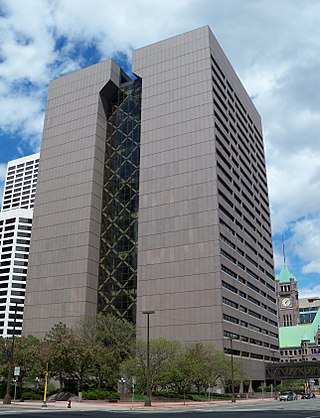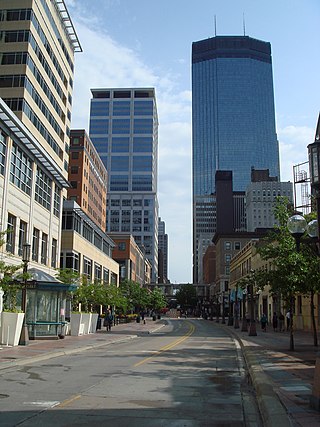
Hennepin County is a county in the U.S. state of Minnesota. Its county seat is Minneapolis, the state's most populous city. The county is named in honor of the 17th-century explorer Father Louis Hennepin. The county extends from Minneapolis to the suburbs and outlying cities in the western part of the county. The county’s natural areas are covered with extensive woods, hills, and lakes.

Nicollet Mall is a twelve-block portion of Nicollet Avenue running through downtown Minneapolis, Minnesota, United States. It is the shopping and dining district of the city, and also a pedestrian mall and transit mall. Along with Hennepin Avenue to the west, Nicollet Mall forms the cultural and commercial center of Minneapolis.

The Minneapolis Public Library (MPL) was a library system that served the residents of Minneapolis, Minnesota in the United States. It was founded in 1885 with the establishment of the Minneapolis Library Board by an amendment to the Minneapolis City Charter. Lumber baron and philanthropist T. B. Walker and other city leaders such as Thomas Lowry were members of the first library board. In 2008, after some financial difficulties, the library was merged into the Hennepin County Library system. At the time of its merger, the library included Central Library in downtown Minneapolis and fourteen branch libraries. Its collection numbered about 3.1 million items with about 2.2 million of these housed in the central library.

Hennepin County Medical Center (HCMC) is a Level I adult and pediatric trauma center and safety net hospital in Minneapolis, Minnesota, the county seat of Hennepin County. The primary 484-bed facility is on six city blocks across the street from U.S. Bank Stadium, with neighborhood clinics in the Minneapolis Whittier and East Lake neighborhoods, and the suburban communities of Brooklyn Center, Brooklyn Park, Golden Valley, St. Anthony and Richfield. A new clinic in the North Loop neighborhood downtown opened in 2017. HCMC has recognized trauma surgery specialists, transplant services, stroke specialists, advanced endoscopy/hepatobilliary center, and hyperbaric oxygen chamber. A new outpatient clinic building opened in 2018. In March 2018, the provider that operates HCMC was rebranded as Hennepin Healthcare. However, the hospital retained the name HCMC.

Minneapolis is the largest city by population in the U.S. state of Minnesota, and the county seat of Hennepin County. The origin and growth of the city was spurred by the proximity of Fort Snelling, the first major United States military presence in the area, and by its location on Saint Anthony Falls, which provided power for sawmills and flour mills.
Minneapolis is the largest city in the state of Minnesota in the United States, and the county seat of Hennepin County.

Hennepin County Library is a public library system serving Hennepin County, Minnesota, US. The current iteration of Hennepin County Library was formed by the merger of urban Minneapolis Public Library and suburban Hennepin County Library on January 1, 2008. The system has 41 library locations, deposit collections at nursing homes and correctional facilities, mail service to the homebound, and extensive outreach services. The library is a department of Hennepin County Government. The library headquarters are in the Ridgedale Library in suburban Minnetonka. The library system has an eleven-member advisory Library Board appointed by the Hennepin County Board of Commissioners. It is a member of the Metropolitan Library Service Agency, a consortium of eight Twin Cities library systems.

Nokomis Library, formerly Nokomis Community Library, is a branch library serving the Nokomis East area of Minneapolis, Minnesota. One of 41 libraries in the Hennepin County Library system, Nokomis was designed by Buetow and Associates, Inc and opened in 1968 as a replacement for the nearby Longfellow Community Library. After being deemed crowded and outdated in 1999, the library underwent a renovation beginning in 2009 that saw it gain a number of environmentally friendly features and an expansion of 4,300 square feet (399 m2). The building reopened in 2011 and includes a restored Wind and Water Chime, a stabile that was part of the original library and that was refurbished and reinstalled by July 2013. The library contains over 35 computers, a public meeting room, and a Spanish-language collection of materials.

The Minneapolis Post Office is the central post office for the city of Minneapolis, Minnesota in the United States. Located on the west bank of the Mississippi River, the facility extends west to east from Hennepin Avenue Bridge to the Third Avenue Bridge and north to south from the West River Parkway on the Grand Rounds Scenic Byway to First Street. Its ZIP code is 55401.

Roosevelt Library is one of 41 community libraries in the Hennepin County Library System, originally part of the Minneapolis Public Library System as it is located in Minneapolis, Minnesota, United States.

Franklin Library is a public library on Franklin Avenue in Minneapolis, Minnesota, United States. The library was one of thirteen branch libraries established under the leadership of Gratia Countryman, the chief librarian of the Minneapolis Public Library from 1904 to 1936. The library housed the largest collection of Scandinavian books, newspapers, and magazines within the system, which reflected the population living in the area. The library was funded by the Carnegie Corporation and designed by Edward Lippincott Tilton, a New York City architect.

Walker Library is a public library in the East Isles neighborhood of Minneapolis, Minnesota, United States. It is on Hennepin Avenue one block north of Lake Street, adjoining the Midtown Greenway.

Minneapolis Central Library, a library in downtown Minneapolis, Minnesota, United States, is the largest library of the Hennepin County Library public library system. It bills itself as having "the third largest per capita public library collection of any major city in America with a collection of more than 2.4 million items—including books, DVDs, music, government documents." The 353,000-square-foot (32,800 m2) building at 300 Nicollet Mall with two levels of underground parking was designed by César Pelli and opened on May 20, 2006. It has over 300 computers for use by the public, an 8,140-square-foot (756 m2) atrium, an 18,560-square-foot (1,724 m2) green roof planted with low-growing ground cover designed to "be sun- and drought-resistant", and a host of energy-efficiency measures.

Northeast Library is a public library in Minneapolis, Minnesota, United States. It is part of the Hennepin County Library system. Since opening in 1973, Northeast Library at 2200 Central Avenue Northeast in Minneapolis serves a vibrant metropolitan community, Northeast, Minneapolis. At 15,275 square feet, the space held about 30,000 books and featured a fireplace to welcome patrons in winter. The 1973 building was itself a replacement for a Carnegie library which was on the site from 1915 until 1972.
North Regional Library is a public library in Minneapolis, Minnesota, United States. It is part of the Hennepin County Library system. Since opening in 1971, North Regional Library at 1315 Lowry Ave. N. in Minneapolis serves a diverse metropolitan community, Near North, Minneapolis.

Washburn Library, formerly Washburn Community Library, is a public library in the Hennepin County Library system. Opened in September 1970, Washburn Library, located at 5244 Lyndale Avenue South in Minneapolis, began with a footprint of 14,451 square feet (1,342.5 m2) and approximately 18,000 books. Designed by Brooks Cavin, an architect who studied under Walter Gropius and Eero Saarinen, Washburn reflected mid-century modernism. Set near Minnehaha Creek, Washburn meets the needs of Southwest Minneapolis in a picturesque neighborhood.
Augsburg Park Library is a public library in Richfield, Minnesota. A Richfield branch library of Hennepin County Library has existed in various buildings in since 1951.

Brooklyn Park Library is a branch of Hennepin County Library serving Brooklyn Park, Minnesota, United States. The current facility opened in June 2016, replacing an earlier library building at 8600 Zane Avenue North that opened in 1976. Prior to that the area was served by Hennepin County Library's bookmobile.

Edina Library is a branch of Hennepin County Library serving Edina, Minnesota, United States.




















